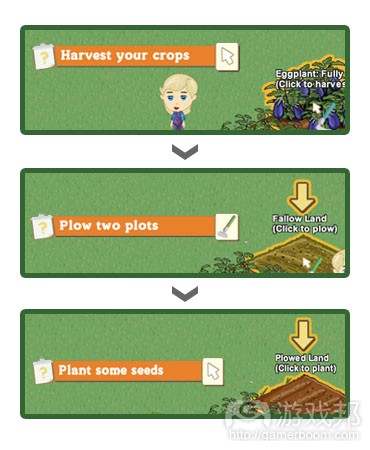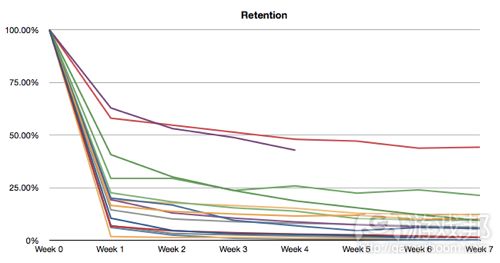新手教程或影响社交游戏首周用户留存率
作者:Tim Trefren
我们有很多客户都是社交游戏开发商,因而比较熟悉Facebook应用的趋势。近期我们发现的大趋势是,游戏利用教程来提升新用户留存率。还有个相关趋势是,游戏发布后数周的留存率对游戏的存活时间至关重要。以下将详细分析这两个趋势。
教程给玩家的印象
我们见过较为成功的做法是基于教程的注册过程。规划精巧的教程可以解除玩家上手游戏的烦恼,教授新用户如何玩游戏。
如果你对这种方法不甚熟悉,可以看下《FarmVille》的注册过程。《FarmVille》的3步教程详细教授你如何收获、耕地和种植。
现在你已经对这个概念有所了解,让我们看看我从一些游戏中收集的数据。
数据
此项分析最令人印象深刻的发现是,每教程步骤推进率平均超过90%。也就是说,一旦某用户开始教程,他们就有超过90%的概率继续实施教程每个步骤。
但这不包括第一步,让玩家开始教程比让他们继续完成教程步骤要难得多。
首步转化率:71.4% 后续步骤转化率:95.06% 完成比率:37.9%。
现在许多公司都在利用教程技术。转化率从未出现95%这么高的数值,但教程似乎确实做到了。
访问留存率趋势
我还注意到留存率行为的另一大趋势。虽然各个游戏的访问留存率在数值上不甚一致,但却有一定的相似性。
访问留存率指的是访问者在首次访问后回头与应用互动的概率。
访问者被分成多个群组(游戏邦注:也称为“同类者”),然后分析整个群组的行为。根据访问日期分组是最普遍采用的方法。比如,5月3日访问游戏的人设为一组。
将访问者分组之后,你可以在接下来数周进行跟踪,查看每个群组中回到站点的数目。
现在,我们来看看各种不同游戏的某些留存数据。为收集这些数据,我首先选取了使用我们服务的几款不同社交游戏。然后,我观察每款游戏每周的平均留存率。
以下是不同游戏周留存率示意图:
我们可以看到,从表面上来看,留存率数值有很大差别。有些游戏的留存率长期维持在50%左右,有些游戏迅速跌近0%。
然而有趣的是,尽管绝对留存率各不相同,各游戏间的留存率变化趋势却很相似。它们都在首周过后急剧下滑,接下来数周趋于平缓。如果你再细心些观察,会发现接下来几周的周留存率几乎没有差别。
我们可以进一步计算出相邻两周间的转化率(游戏邦注:比如第3周数值除以第2周数值)。以下是转化率示意图:
是否发现什么规律呢?游戏从发布之初到第1周的转化率各不相同,从最低的1.76%到最高的62.83%。但是,无论初始转化率是高还是低,接下来几周几乎所有游戏的转化率都接近80%。
换句话说,游戏首周的用户有80%的概率在接下来几周会回到游戏中。
这意味着首周留存率很重要,因为你一旦留住用户1周时间,他们就很有可能长久选择这款游戏。这种现象也产生了另一个问题:为何我们所选的这些游戏的表现都如此相似呢?或许社交游戏就是如此,所有游戏的留存用户都有80%到95%的概率每周回到游戏中?如果事实真是如此,这意味着你只需要控制初始留存率即可。开发商们,是时候编写和润色游戏教程了!
游戏邦注:本文发稿于2010年6月29日,所涉时间、事件和数据均以此为准。(本文为游戏邦/gamerboom.com编译,如需转载请联系:游戏邦)
Mixpanel: Social Game Developers Use Tutorials to Get Crucial Early Retention
Tim Trefren
Because a range of our customers are social game developers, we can get a high-level look at trends they’re seeing in their Facebook applications. One of the big trends we’re seeing is that games are using tutorials to generate strong retention among new users. A related trend is that this initial retention is critical to the health of your game, in the weeks following launch. Here’s a closer look.
Impressive Results From Tutorials
One thing we’re seeing succeed is the tutorial-based signup process. A well-crafted tutorial removes all the ambiguity out of getting started and helps teach a new user how to play the game.
If you’re not familiar with this technique, the FarmVille signup process is a good example. FarmVille explicitly teaches you how to harvest, plow, and plant seeds with a 3-step tutorial.
Now that you’re familiar with the concept, let’s take a look at the data I’ve compiled from a number of games.
By The Numbers
The most impressive finding of this analysis is that individual steps in a tutorial convert at over 90% on average. Meaning, once a user has started a tutorial, they have a greater than 90% chance of continuing at each step.
This doesn’t include the first step, however – as you might expect, it’s harder to get users to start a tutorial than it is to get them to complete additional steps.
First step conversion rate: 71.4% Additional step conversion rate: 95.06% Overall completion rate: 37.9%
Many companies are now utilizing the tutorial technique, and it clearly deserves its popularity. Conversion rates of 95% are practically unheard of, but tutorials appear to be delivering these results.
An Interesting Trend in Visitor Retention
Another thing I noticed was a strong trend in retention behavior. There are some remarkable similarities in the *pattern* of visitor retention across games, despite the differences in the actual numbers.
Before I go any further, here’s a quick overview of the concept: Visitor retention is the percentage of visitors who come back and interact with an application after their first visit.
Visitors are chunked into groups—also known as ‘cohorts’—and then analyzed based on the the behavior of the group as a whole. The most common method is to group by visit date. For example, one group might consist of all the visitors who were first seen in the week starting May 3rd.
Once you have grouped your visitors, you can track them over the following weeks and see how many from each cohort return to the site.
Now let’s look at some actual retention numbers for a variety of different games. To compile this data, I first took a sample of the different social games using our service. Then I looked at the average week-over-week retention for each game.
Here’s a graph of the average weekly retention rates for the different games:
You can see that on the surface, the retention numbers are pretty different – some of these games have long-term retention rates close to 50%, while others rapidly approach 0%.
However, the interesting thing to note is that while the absolute retention rates are different, the pattern of retention is very similar across games. They all have a massive dropoff after the first week, with relatively flat retention in the following weeks. If you take a closer look, the ‘flat’ parts of the graph run nearly parallel, meaning they have very similar weekly conversion rates.
We can take a closer look by calculating the “conversion rate” – (e.g. week 3 divided by week 2, etc) between adjacent weeks. Here’s a graph with this transformation:
See a pattern? At the first point on the x-axis (Week 0-1), we can see that the initial conversion rate ranged from 1.76% on the low end to 62.83% on the high end. The interesting part comes later, though – no matter what the initial conversion rate between weeks 0 and 1, the following weeks convert at close to 80% across all of the games.
Basically, this means that once you’ve had a user for at least a week, they have an 80% chance of coming back each following week.
This suggests that your initial retention rate is critical, because once you’ve retained users for a week you are likely to keep them for quite a while. This behavior also raises another question: why do almost all of the games in our sample exhibit this behavior? Is it possible that this is just how social games work – retained users have an 80 – 95% chance of returning each week? If so, this could mean that the only thing you have control over is the initial retention rate. Time to write and polish your tutorials. (Source: Inside Social Games)
下一篇:阐述社交游戏与街机游戏的相同点










































 闽公网安备35020302001549号
闽公网安备35020302001549号